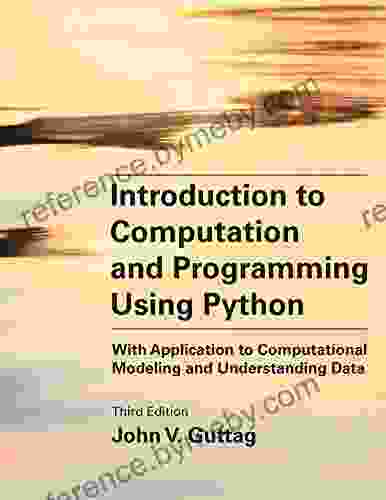Advanced Machine Learning with Applications to Computational Modeling and Understanding Data

Machine learning is a rapidly growing field that has the potential to revolutionize many aspects of our lives. By learning from data, machines can perform tasks that were once thought to be impossible, such as recognizing speech, translating languages, and diagnosing diseases. Machine learning is also essential for computational modeling, which is used to create simulations of complex systems such as the weather, the economy, and the human body.
4.5 out of 5
| Language | : | English |
| File size | : | 16134 KB |
| Text-to-Speech | : | Enabled |
| Screen Reader | : | Supported |
| Enhanced typesetting | : | Enabled |
| X-Ray | : | Enabled |
| Print length | : | 872 pages |
In this book, we will introduce you to the fundamental concepts of machine learning and show you how to apply them to a variety of real-world problems. We will cover a wide range of topics, from supervised and unsupervised learning to deep learning and reinforcement learning. By the end of this book, you will be able to build and deploy powerful machine learning models that can solve complex problems in computational modeling and understanding data.
Supervised Learning
Supervised learning is a type of machine learning in which the model learns from a dataset of labeled data. The labels indicate the correct output for each input, and the model learns to map inputs to outputs by minimizing the error between its predictions and the labels. Supervised learning is used for a variety of tasks, such as classification, regression, and object detection.
There are many different supervised learning algorithms, each with its own strengths and weaknesses. Some of the most popular supervised learning algorithms include:
- Linear regression
- Logistic regression
- Support vector machines
- Decision trees
- Random forests
- Gradient boosting machines
Unsupervised Learning
Unsupervised learning is a type of machine learning in which the model learns from a dataset of unlabeled data. The model must find patterns and structure in the data without being told what to look for. Unsupervised learning is used for a variety of tasks, such as clustering, dimensionality reduction, and anomaly detection.
There are many different unsupervised learning algorithms, each with its own strengths and weaknesses. Some of the most popular unsupervised learning algorithms include:
- K-means clustering
- Hierarchical clustering
- Principal component analysis
- Linear discriminant analysis
- Autoencoders
Deep Learning
Deep learning is a type of machine learning that uses artificial neural networks to learn from data. Artificial neural networks are inspired by the human brain, and they can learn to recognize patterns and make complex decisions. Deep learning is used for a variety of tasks, such as image recognition, natural language processing, and speech recognition.
There are many different deep learning architectures, each with its own strengths and weaknesses. Some of the most popular deep learning architectures include:
- Convolutional neural networks
- Recurrent neural networks
- Transformer networks
- Autoencoders
- Generative adversarial networks
Reinforcement Learning
Reinforcement learning is a type of machine learning in which the model learns by interacting with its environment. The model receives rewards and punishments for its actions, and it learns to choose actions that maximize its rewards. Reinforcement learning is used for a variety of tasks, such as game playing, robot control, and resource allocation.
There are many different reinforcement learning algorithms, each with its own strengths and weaknesses. Some of the most popular reinforcement learning algorithms include:
- Q-learning
- SARSA
- Deep Q-learning
- Actor-critic methods
- Policy gradient methods
Applications to Computational Modeling and Understanding Data
Machine learning has a wide range of applications to computational modeling and understanding data. In this section, we will discuss a few of these applications.
Computational Modeling
Machine learning can be used to create simulations of complex systems such as the weather, the economy, and the human body. These simulations can be used to predict future events, test new policies, and gain a better understanding of the underlying mechanisms of these systems.
For example, machine learning is being used to develop climate models that can predict future climate change. These models can help us to understand the potential impacts of climate change and to develop strategies to mitigate its effects.
Understanding Data
Machine learning can also be used to understand data. By identifying patterns and relationships in data, machine learning can help us to gain insights into complex phenomena. This can help us to make better decisions, design better products, and improve our understanding of the world.
For example, machine learning is being used to develop personalized medicine. By analyzing patient data, machine learning algorithms can identify patterns that can be used to predict the risk of disease, recommend treatments, and monitor patient outcomes.
Machine learning is a powerful tool that can be used to solve complex problems in computational modeling and understanding data. In this book, we have introduced you to the fundamental concepts of machine learning and shown you how to apply them to a variety of real-world problems. By the end of this book, you will be able to build and deploy powerful machine learning models that can help you to make better decisions, design better products, and improve your understanding of the world.
4.5 out of 5
| Language | : | English |
| File size | : | 16134 KB |
| Text-to-Speech | : | Enabled |
| Screen Reader | : | Supported |
| Enhanced typesetting | : | Enabled |
| X-Ray | : | Enabled |
| Print length | : | 872 pages |
Do you want to contribute by writing guest posts on this blog?
Please contact us and send us a resume of previous articles that you have written.
 Book
Book Novel
Novel Page
Page Chapter
Chapter Text
Text Story
Story Genre
Genre Reader
Reader Library
Library Paperback
Paperback E-book
E-book Magazine
Magazine Newspaper
Newspaper Paragraph
Paragraph Sentence
Sentence Bookmark
Bookmark Shelf
Shelf Glossary
Glossary Bibliography
Bibliography Foreword
Foreword Preface
Preface Synopsis
Synopsis Annotation
Annotation Footnote
Footnote Manuscript
Manuscript Scroll
Scroll Codex
Codex Tome
Tome Bestseller
Bestseller Classics
Classics Library card
Library card Narrative
Narrative Biography
Biography Autobiography
Autobiography Memoir
Memoir Reference
Reference Encyclopedia
Encyclopedia Laura Klein
Laura Klein Agustin Fuentes
Agustin Fuentes Albert Badre
Albert Badre Susan E B Schwartz
Susan E B Schwartz Alaya Books
Alaya Books Alan Axelrod
Alan Axelrod Ian Frazier
Ian Frazier Maureen Duffin Ward
Maureen Duffin Ward Lesley Jane Eales Reynolds
Lesley Jane Eales Reynolds Adolph L Reed
Adolph L Reed Adrian Bell
Adrian Bell Alberto Partida
Alberto Partida Glynn Wilson
Glynn Wilson Mel Thompson
Mel Thompson Alan Watkins
Alan Watkins Zane Grey
Zane Grey Dr Rupy Aujla
Dr Rupy Aujla Agnes Day
Agnes Day Al Lieberman
Al Lieberman Alan E Beer
Alan E Beer
Light bulbAdvertise smarter! Our strategic ad space ensures maximum exposure. Reserve your spot today!

 Phil FosterOn Our Own in Jerusalem Old City: A Captivating Odyssey Through the Heart of...
Phil FosterOn Our Own in Jerusalem Old City: A Captivating Odyssey Through the Heart of... Ted SimmonsFollow ·14.6k
Ted SimmonsFollow ·14.6k Roberto BolañoFollow ·11.5k
Roberto BolañoFollow ·11.5k Asher BellFollow ·6.2k
Asher BellFollow ·6.2k Brian WestFollow ·13k
Brian WestFollow ·13k Bob CooperFollow ·5.6k
Bob CooperFollow ·5.6k Darren BlairFollow ·13.3k
Darren BlairFollow ·13.3k Stanley BellFollow ·12.6k
Stanley BellFollow ·12.6k Evan HayesFollow ·2.1k
Evan HayesFollow ·2.1k

 Brandon Cox
Brandon CoxStronger: Forty Days of Metal and Spirituality
A 40-day...

 Dustin Richardson
Dustin RichardsonDelve into the Gripping World of British Crime: DCI Kett...
Unveiling the Intricate Tapestries of Crime...

 Giovanni Mitchell
Giovanni MitchellTrue Wealth Starts In The Mind: Unleash Your Inner...
In the pursuit of...

 Duncan Cox
Duncan CoxPulse Pounding British Crime Thriller: DCI Kett Crime...
Prepare for...

 Dashawn Hayes
Dashawn HayesUnveiling the Unwavering Strength and Inspiring Journey...
In the annals of wrestling history, the name...
4.5 out of 5
| Language | : | English |
| File size | : | 16134 KB |
| Text-to-Speech | : | Enabled |
| Screen Reader | : | Supported |
| Enhanced typesetting | : | Enabled |
| X-Ray | : | Enabled |
| Print length | : | 872 pages |












